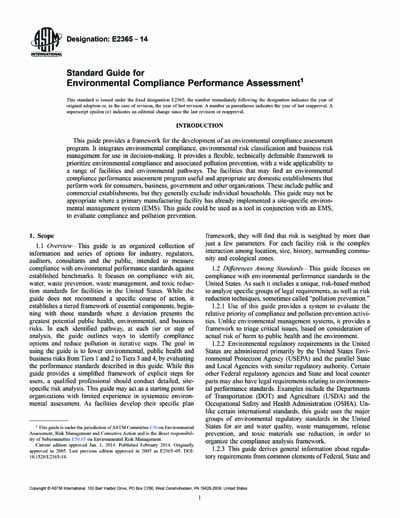Historical
ASTM E2365-14
Standard Guide for Environmental Compliance Performance Assessment
1.1 Overview—This guide is an organized collection of information and series of options for industry, regulators, auditors, consultants and the public, intended to measure compliance with environmental performance standards against established benchmarks. It focuses on compliance with air, water, waste prevention, waste management, and toxic reduction standards for facilities in the United States. While the guide does not recommend a specific course of action, it establishes a tiered framework of essential components, beginning with those standards where a deviation presents the greatest potential public health, environmental, and business risks. In each identified pathway, at each tier or step of analysis, the guide outlines ways to identify compliance options and reduce pollution in iterative steps. The goal in using the guide is to lower environmental, public health and business risks from Tiers 1 and 2 to Tiers 3 and 4, by evaluating the performance standards described in this guide. While this guide provides a simplified framework of explicit steps for users, a qualified professional should conduct detailed, site-specific risk analysis. This guide may act as a starting point for organizations with limited experience in systematic environmental assessment. As facilities develop their specific plan framework, they will find that risk is weighted by more than just a few parameters. For each facility risk is the complex interaction among location, size, history, surrounding community and ecological zones.
1.2 Differences Among Standards—This guide focuses on compliance with environmental performance standards in the United States. As such it includes a unique, risk-based method to analyze specific groups of legal requirements, as well as risk reduction techniques, sometimes called “pollution prevention.”
1.2.1 Use of this guide provides a system to evaluate the relative priority of compliance and pollution prevention activities. Unlike environmental management systems, it provides a framework to triage critical issues, based on consideration of actual risk of harm to public health and the environment.
1.2.2 Environmental regulatory requirements in the United States are administered primarily by the United States Environmental Protection Agency (USEPA) and the parallel State and Local Agencies with similar regulatory authority. Certain other Federal regulatory agencies and State and local counter parts may also have legal requirements relating to environmental performance standards. Examples include the Departments of Transportation (DOT) and Agriculture (USDA) and the Occupational Safety and Health Administration (OSHA). Unlike certain international standards, this guide uses the major groups of environmental regulatory standards in the United States for air and water quality, waste management, release prevention, and toxic materials use reduction, in order to organize the compliance analysis framework.
Content Provider
ASTM International [astm]






